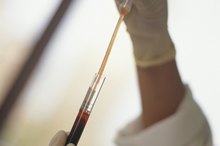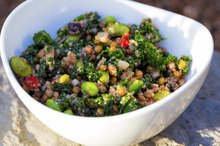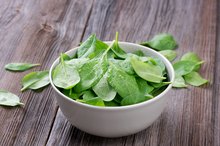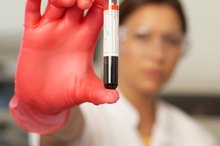What Are the Dangers of Being Anemic?
If you were to look under the microscope at a sample of your blood, you would see scores of red, doughnut-shaped cells known as erythrocytes. Red blood cells number in the millions per cubic milliliter of blood and are the most numerous cell type in the body, according to University of Maryland Medical Center. Anemia is an umbrella term that refers to an inadequate number of red blood cells. It can result from iron, folate or vitamin B-12 deficiencies. It's essential to have your type of anemia diagnosed by a physician to prevent complications.
The Role of Erythrocytes
The function of red blood cells is to deliver oxygen to every cell in the body. At the center of each erythrocyte is a hemoglobin complex composed of a protein called globulin and an iron-binding molecule called heme. The hemoglobin complex allows erythrocytes to bind oxygen in the lungs. Red blood cells carry oxygen to body tissues, release it and bind carbon dioxide, which is a waste product. The carbon dioxide is released in the lung tissue and exhaled. Your body needs folate, vitamin B-12 and iron to grow and to form healthy red blood cells.
- The function of red blood cells is to deliver oxygen to every cell in the body.
Dangers of Iron Deficiency Anemia
Signs & Symptoms of Mild Anemia
Learn More
The mildest symptoms of iron deficiency anemia include irritability, tiredness, headache and difficulty focusing. As the anemia progresses, the symptoms become more pronounced. The biggest danger associated with moderate anemia is shortness of breath. Other symptoms include brittle nails and hair, pallor, a blue tinge to the whites of your eyes, dizziness and a sore tongue. Athletes are likely to experience reduced endurance with this type of anemia. In cases of advanced iron deficiency anemia, the body literally becomes starved for oxygen. The most serious dangers include organ failure, irregular heartbeat called arrhythmia and heart failure.
- The mildest symptoms of iron deficiency anemia include irritability, tiredness, headache and difficulty focusing.
Dangers of Folate Deficiency Anemia
The symptoms of folate deficiency include fatigue, pallor, headache and sore tongue and mouth. A more serious deficiency may cause other cosmetic alterations including curling and graying of the hair and changes to skin pigmentation. Anemia is of particular concern with pregnant women because a folate deficiency can cause neural tube defects in her unborn child. Other dangers include a worsening of heart disease and heart failure and infertility.
- The symptoms of folate deficiency include fatigue, pallor, headache and sore tongue and mouth.
- A more serious deficiency may cause other cosmetic alterations including curling and graying of the hair and changes to skin pigmentation.
Dangers of B-12 Deficiency Anemia
Signs & Symptoms of Mild Anemia
Learn More
Mild symptoms associated with B-12 deficiency anemia include diarrhea or constipation, fatigue, shortness of breath, swollen red or bleeding gums, pallor, difficulty concentrating, lack of appetite and shortness of breath. The most serious danger of this deficiency is nerve damage. Signs of deficiency-related damage include numbness or tingling of the extremities, confusion, dementia, loss of balance and depression.
Dietary Solutions
A diverse, nutritious diet is essential for anemia prevention. Foods rich in folate include leafy, green vegetables and citrus fruits. Before and during pregnancy, women should take supplemental folic acid in addition to eating a healthy diet. Dietary sources of vitamin B-12 include meat, poultry, shellfish and dairy products. Lentils, peas, beans, red meat, poultry, soybeans, whole-grain bread, fortified cereal, some dried fruit and dark, leafy greens are all good sources of iron. Some anemias cannot be treated only with diet. If you've been diagnosed with a nutrient deficiency, work with your physician to ensure proper treatment.
- A diverse, nutritious diet is essential for anemia prevention.
- Before and during pregnancy, women should take supplemental folic acid in addition to eating a healthy diet.
Related Articles
References
- University of Maryland Medical Center: Anemia
- MedlinePlus: Iron Deficiency Anemia
- New York Times Health Guide: Anemia
- University of Maryland Medical Center: Folate-Deficiency Anemia
- University of Maryland Medical Center: Anemia-B12 Deficiency
- MedlinePlus. Anemia. Updated December 10, 2019
- Cappellini MD, Comin-colet J, De francisco A, et al. Iron deficiency across chronic inflammatory conditions: International expert opinion on definition, diagnosis, and management. Am J Hematol. 2017;92(10):1068-1078. doi:10.1002/ajh.24820
- American Society of Hematology. Anemia.
Writer Bio
Carolyn Robbins began writing in 2006. Her work appears on various websites and covers various topics including neuroscience, physiology, nutrition and fitness. Robbins graduated with a bachelor of science degree in biology and theology from Saint Vincent College.








